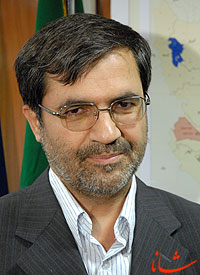Seyed Mahmoud Mohaddes talking to reporters in a news session added the drilling operations of Karanj field ended and new resources of crude oil were explored in the region.
The official said further studies would be conducted and the NIOC Managing Director Gholam-Hossein Nozari would give good news in this regard within the next days.
“In addition, we break other good news on exploration of new oil and gas reservoirs by September,” vowed the manager.
Shifting to the outcome of negotiations on new 17 exploration blocks, he said 11 domestic and foreign companies had up to now purchased the documents of related tenders and more companies had expressed their eagerness to buy the documents before the deadline.
Mohaddes termed foreign companies’ welcome of tenders as positive and added the documents were purchased by Asian, European, and Canadian companies, out of which six were European.
“So far, 42 packages of information about new exploration fields have been submitted to these companies,” said the NIOC official, adding, “It means some of them have purchased the documents of more than four fields and some have voiced their willingness to make studies on exploration operations in eight oil blocks.”
According to him, at least 450 million euros should be invested for exploration operations in these 17 oil blocks.
Mohaddes, however, said the figure could soar when the outcome of exploration operation was determined.
“The country has been divided into 96 exploration regions and contracts on 11 blocks of these regions have been signed and are being put into action currently,” he added.
“Fifteen companies from 12 foreign countries are doing exploration operations in these blocks, investing at least 700 million dollars in the region.
“Companies from
The NIOC’s exploration manager added, “We used the Ministry of Petroleum’s asset and hard currency fund for exploration operations in the past Iranian calendar year (March 21, 2006 to March 20, 2007) and the executive companies spent 171 million dollars during the yearlong period, bringing the total sum invested in the blocks to 443 million dollars.
“Drilling exploration wells in the previous year, we managed to explore several oilfields in the blocks, including the reserve in
Mohaddes added two drilling operations in the pre-revolution era had yielded nothing, but the oil industrialists, thanks to their unflinching efforts, managed to explore oil in great depths of the field last year.
“The in situ crude oil and gas condensates of the field amount to 650 million barrels,” revealed the official, adding 170 million barrels of the figure was derivable.
He said the field’s in-place gas equaled to 990 billion cubic feet and predictions indicated that some 700 billion cubic feet is extractable.
Last month, the NIOC Managing Director Nozari confirmed the exploration of new gas reserves in southern
“Geological data show that there are gas deposits in the two cities of Larestan and Fassa in
He said geological surveys and seismographic results proved that the province had the desirable capacity to meet domestic gas need.
“We have to keep on drilling in Larestan and Fassa,” said Nozari, adding, “
The ranking official added, “We are conducting more studies on other cities of
“Oil exploration helps a region develop industry and technology.”
According to Nozari, the country is presently producing 4.2 million barrels of oil per day and the daily gas output amounts to about 300 million cubic meters.
National Iranian South Oil Co. (NISOC) technical manager had already announced that the company had discovered a reservoir with an initial two billion barrels of in-place oil.
Hassan Shokrollahzadeh-Behbahani added the company’s experts using three-dimensional (3-D) seismographic data on Bangestan reservoir of Ab-Teimur oilfield explored the new reservoir.
According to the data, the reservoir’s area is about 40 square kilometers, said the official.
He added geophysical software showed that the reservoir’s petrophysical features enjoyed higher quality when compared to those of similar ones.
“To have more accurate information, we need supplementary data through two-dimensional seismographic survey,” said the manager.
Five of the blocks are offshore and the rest are onshore.
According to the deadline, the bidders were to get the information no later than March 17 and they have to buy the tender documents maximum by
Following the purchase of documents and study of risks and economic justifications of the blocks, they make their final decision and offer their technical and financial proposals.
The information room was highly welcome, indicating the willingness of domestic and foreign companies to purchase the documents.
Over 30 domestic and foreign companies visited the information room, indicating a 20 percent increase when compared to the figure in the previous edition.”
Giants Total, Shell, Repsol and companies from
Nozari had already said that 90 foreign firms had shown an interest in 17 new onshore and offshore blocks.
The
In January 2002, the NIOC also held an international tender for the exploration and development of 16 oil blocks at a conference in
Covering an area of 128,980 square kilometers, the 17 blocks are located in Khorassan Razavi, North Khorassan, Semnan, Ardebil and some part of East Azarbaijan, Golestan, some areas of Ilam and Kermanshah, Fars, and Hormuzgan provinces.
The 12 blocks of Qouchan, Kalat, Raz, Maraveh Tappeh, Moghan 1 and 2, Naftshahr, Ilam, Danan, Fassa, and Bandar Abbas are onshore and the five, Alvand, Deir, Ferdows, Laleh and Taban, are in the


Your Comment